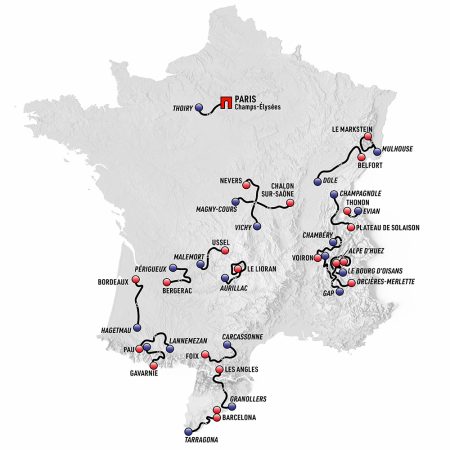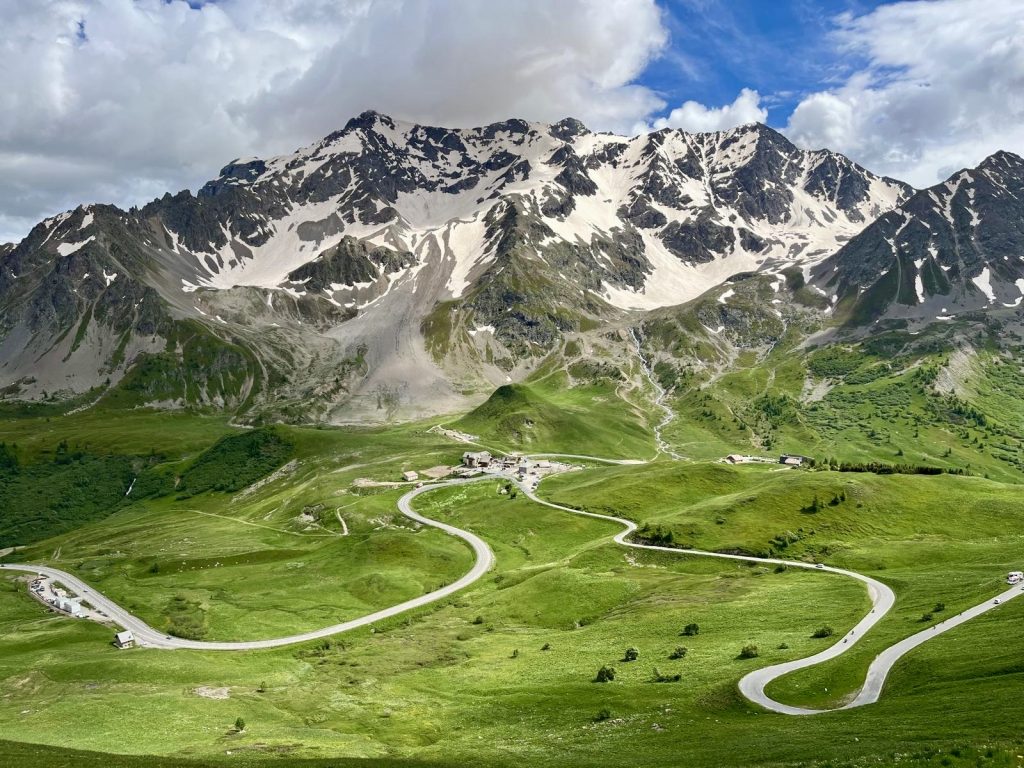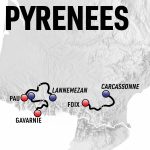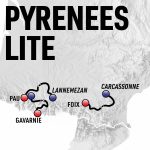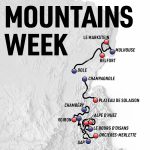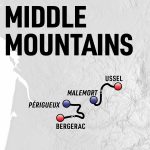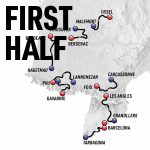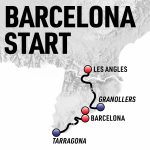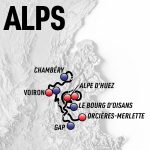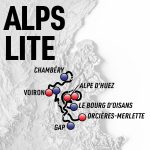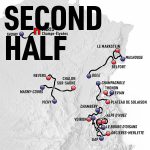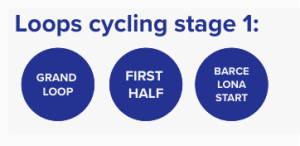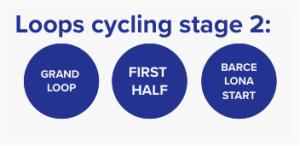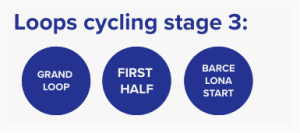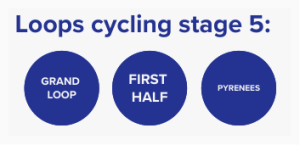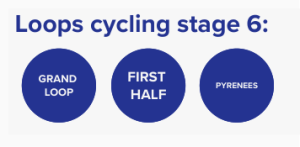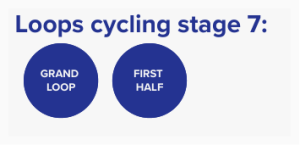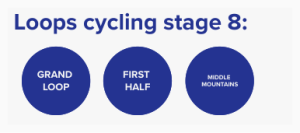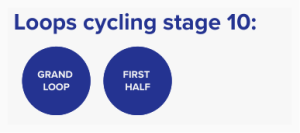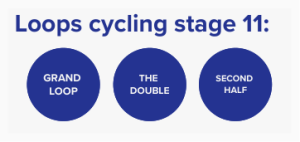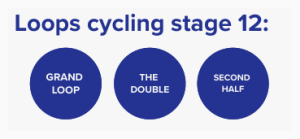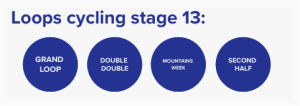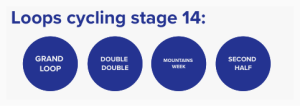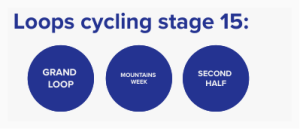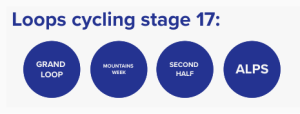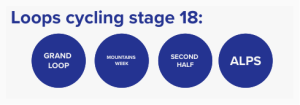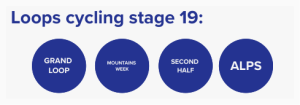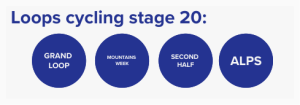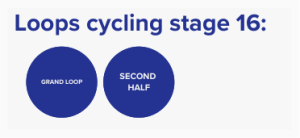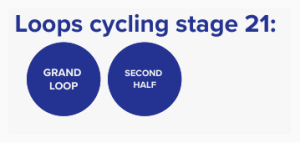The Route 2026: Barcelona to Paris
Sat 27th June - Mon 20th July
Grab your castanets, we’re heading to the home of tapas, the Sagrada Familia and creme Catalan!
The first stage is (for the Pros) a 19.7km team time trial around the City of Barcelona. We won’t race it as teams; instead we’ll enjoy the opportunity for a sight-seeing ride past the port and beaches, the Sagrada Familia and a finish at the Monjuic Olympic park complex. It’s a true “Hello Barcelona” moment on bikes and a wonderful way to meet fellow cyclists and consider what lies ahead…
Le Loop Logistics
Start: Barcelona hotel
Finish: Barcelona hotel
Stage 2 is a beauty: we’ll start with a transfer south west along the coast to Tarragona and we cycle back to our finish in Barcelona (note, two nights in the same hotel!).
The first half of the 176km ride is as good as flat (famous last words) with all of the atmosphere, coastal views and Catalan feel you could hope for. This will feel fast and the feedstops will come quickly – so that by early afternoon we’re already approaching the big city…
But then as we approach Barcelona, the route turns left and veers off into the hills for a few punchy climbs to test us, and culminates in three laps of the Olympic park (that’s three more little hill climbs) to finish. A truly spectacular Spanish stage!
Le Loop Logistics
Start: Transfer to Tarragona
Finish: Barcelona hotel
Today’s ride takes us into the lush green hinterland of Catalunya. We roll briskly out of the bustling market town of Granollers, and very quickly find ourselves in the steep, verdant hills that form Barcelona’s hinterland. Within an hour we hit our first climb of the day: a 7.6km haul up to the scenic hilltop town of Sant Feliu de Codines, and from here a winding balcony road offers panoramic views of the otherworldly rock formations of the Tenes Gorge.
After a rolling descent to the Plain of Vic, our route plunges us back into the hills, and we gain height steadily as we follow river valleys north to Ribes de Freser, a historic town famous for its mineral water. From here it’s a long, but fairly steady climb up to Col de Toses, and then we have around 20km of descent into the high-altitude Cerdanya Valley, which spans the border with France.
Soon after thinking we’ve made it to France, confusion will set in when everything looks Spanish again; it’s a brief visit to the tiny Llívia, a 13 km2 Spanish enclave which has been cut off from the rest of Spain ever since the two countries negotiated their borders in 1659. Returning once again to France, a set of sharp hairpins will take us up out of the valley, with views of Llívia’s ruined castle, and onwards to Fort-Romeu, which at 1,800m is home to France’s National Altitude Training Centre – so keep an eye out for elite athletes as we pass through.
There are two more descents, and two more climbs, before we reach the pretty resort of Les Angles.
*LITE: We’ll give you a lift to feedstop 2 in Ripoll at 90km, making the stage a more friendly 96km and 2,270m ascent
*only available to those who have signed up for the Barcelona Start Loop (Lite options are not designed for Grand or longer Loopers)
Le Loop Logistics
Start: Transfer to Granollers
Finish: Transfer to Carcassonne hotel
Departing from Carcassonne, we start the day with a couple of hours of rolling roads through quiet countryside – big skies, fragrant foliage, and the occasional vineyard. If it’s a clear day, we may see mountains looming on the horizon and, following the short climb up to Villerouge-Termenès, we get to admire one of the many Cathar castles that dot this ancient landscape.
Our elevation gain is fairly evenly spread throughout the day’s ride, but the two biggest climbs come in its second half, as we move into the foothills of the Pyrenees. Setting off from Quillan, with its stone buildings and picturesque red roof tiles, we ascend up out of the valley, via gentle, tree-lined gradients, to the Col de Coudons. We keep our elevation for the next hour or so, rolling across the Plateau de Sault: a remote highland region of the Pyrenees where tourists seldom tread.
After descending through an ancient fir forest into Bélesta, we tackle the Col de Montségur which, with an average gradient of 6.6%, should be our toughest ascent of the day. As we follow the climb’s twists and turns we catch glimpses of the imposing Château de Montségur, which perches on a rocky outcrop, far higher than we go today. The final hour or so of cycling is mostly downhill, albeit with a few noticeable bumps, and we end our ride in the medieval city of Foix, overlooked by yet another château.
*LITE: There is a short cut towards the end of the stage that cuts out 53km and 800m of climbing, making the stage a more manageable 149km with 1950m of ascent
*only available to those who have signed up for either the Pyrenees/Pyrenees Lite Loop options (lite options are not designed for Grand or longer Loopers).
Le Loop Logistics
Start: Carcassonne hotel
Finish: Foix hotel
This stage is billed as being flat, and actually includes more downhill than up – but don’t let that lull you into complacency! There’s still plenty of climbing, albeit only in small doses, as the road takes us in and out of the countless small river valleys that run through this fertile region of France like the veins of a leaf. This is the stage where you can expect those classic Tour views of sunflowers, vineyards, and towering avenues of plane trees.
We begin in Armagnac country, where grapes have been grown – and spirits distilled – since Roman times. Starting our ride with a descent from the Plateau de Lannemezan, we then head west through Castelnau-Magnoac, briefly admiring its half-timbered buildings before crossing several small watersheds. After a series of five short climbs, we pass through the handsome market town of Trie-sur-Baïse (they should have plenty of leftover decorations from having hosted a stage start in 2018!), and continue our gentle downhill progress.
There are more rolling hills as we wind our way across the quiet countryside, past fields of sunflowers, and the vineyards that have brought generations of wine-lovers to this area. A few more ups and downs take us through cornfields and quiet villages to the lip of the Ousse Valley, and from here it should be an easy descent into Pau.
*LITE: We don’t anticipate many cyclists choosing a lite option as this is a great opportunity to ride a full Tour stage. However, for those in need, we’ll give you a lift to the first feedstop
*only available to those who have signed up for either the Pyrenees/Pyrenees Lite Loop options (lite options are not designed for Grand or longer Loopers).
Tour logistics
Start: Transfer to Lannemezan
Finish: Pau hotel
Today’s ride offers everything you want from a mountain stage – including the nervous excitement as we roll south through the suburbs of Pau and the rolling farmland that surrounds it, watching the mountains draw closer and closer on the horizon.
The landscape will gradually close in around us as we approach the historic pilgrimage centre of Lourdes, and we spend the next couple of hours fairly low down, winding our way through the foothills as we enjoy the wooded slopes and tranquil villages of this region where the mountains meet the lowlands. Then, finally, we turn south into the tight valley of the River Neste, whose icy-cold torrent will accompany us all the way to the foot of the Col d’Aspin, our first big climb.
The Aspin is a beautiful, and very popular climb, with 12km of hairpins, a fairly steady gradient of 6.5%, and increasingly fine views as we move up above the tree line. Take a moment to catch your breath at the top, before plunging down to Sainte-Marie-de-Campan: the site of one of the Tour de France’s most enduring legends. This small village is where Eugène Christophe famously repaired his own fork using a local blacksmith’s forge, having broken it on the descent from the Tourmalet.
We then head up the way he came down, enjoying the Giant of the Pyrenees from its shorter – and slightly steeper – side. En route we pass through the Brutalist ski resort of La Mongie, seeing llamas on the upper slopes if the weather’s clear. Then, after 20km of descent, we head south again for the crowning glory of today’s stage: a very rare opportunity to visit magical Gavarnie. We get to savour the increasingly spectacular scenery of this remote valley as we ride its relatively steady gradients (this is an 18.7km climb, at an average of 3.7%), and if it’s a clear day, we may be able to see the magnificent Cirque de Gavarnie – and the highest waterfall in mainland France – from the finish.
*LITE: A short cut from Bagnerre de Bigorre to Ste Marie de Campan cuts out the Aspin whilst keeping the Tourmalet and Gavarnie climb. The stage is reduced to 131km with 3,000m of climbing
*only available to those who have signed up for either the Pyrenees/Pyrenees Lite Loop options (lite options are not designed for Grand or longer Loopers).
Tour logistics
Start: Pau hotel
Finish: Gavarnie hotel
There’s very little climbing on today’s stage, and much of it will take place on long, straight roads that take us rapidly through the shady pine forests of the Landes department, before we emerge into the vineyards that surround Bordeaux. The trees should shelter us from the worst of the coastal side winds, leaving us to enjoy the flawless French tarmac, and the company of our fellow riders.
Listen out for explosions (!) as we pass close to the village of Captieu: this is Europe’s largest military firing range and test area, covering an area almost as big as Paris. Despite these occasional disruptions, the site is also home to around 70 protected species, and we may well catch glimpses of curlews and common cranes as we roll past.
There are a few small climbs towards the end of the day, as we move into the fertile wine country for which Bordeaux is famous, but the scenery makes up for it – countless chateaux, rolling vineyards, and the lazy River Garonne, which accompanies us into the city.
Tour logistics
Start: Transfer to Hagetmau
Finish: Transfer to Perigueux
Expect a summer holiday feeling on this stage which is entirely in the Dordogne area of France. Scenery-wise, it’s a French paradise, with fairytale chateaux, spectacular rock formations, and village after spectacular village built from honey-coloured stone.
The route is a near-copy of a 2017 stage which French TV viewers voted as the most beautiful stage of that year’s Tour. Whilst the helicopters will be busy for the pros, we get to enjoy the view from the ground; cycling through the archways of fortified city walls, under the rocky limestone overhangs and alongside the river that gives its name to the region.
Our morning’s ride takes us close to the Lascaux caves, where 17,000-year-old paintings showcase the skills and interests of our ancestors. The route winds through the region in a big loop, taking in as much of the regional scenery as possible with many gasps and “wow” moments as we round corners along the route today! Then the afternoon keeps close to the river and the visual treats keep coming, with views of vineyards replacing the river gorge scenery as we get closer to Bergerac.
For a Tour stage, 1,150m of climbing is nothing. It’s the second stage in a row designed for sprinters and a total joy for us amateurs. It’s impossible to describe the exceptional scenery of stage 8; this is a world away from home and an absolutely charming day of cycling. There’s every chance that stage 8 will get voted top for beauty again in 2026!
Tour logistics
Start: Perigueux hotel
Finish: TBC
The Massif Central, a remote range of mountains deep in the interior of France, has a completely different feel to the Alps and the Pyrenees, and although the region is popular with French holiday makers, it’s also very thinly populated, so we should feel like we have the place to ourselves for much of the day.
There is barely any flat terrain on this stage, and the climbing begins almost immediately as we set off into the wooded hills that surround Malemort (a suburb of the better known Brive la Gaillarde). Following winding, view-filled balcony roads, we make our way south, and then north, eventually descending into the smart riverside town of Tulle, the accordion capital of France!
Heading out of Tulle via the steady climb of the Côte de Naves, we dip down to the River Vimbelle, before ascending through chestnut and pine woodland to Chaumeil, a small town with glistening slate rooves whose pitches foreshadow the massive climb that lies ahead of us. Suc au May, today’s only categorised climb, is quiet but deadly, with an ever-changing gradient that means it’s difficult to get into a rhythm. The road emerges from the trees towards the summit, giving us momentary views of the distant hilltops before we begin our descent to Treignac, a charming medieval town with a 13th-century bridge and numerous half-timbered houses, overlooked by a famous twisted bell tower.
There will be more views to enjoy on our ascent of Mont Bessou – the high point of today’s stage, at 977m – and from here it’s mostly downhill to Ussel, a small town in the middle of the “plateau of a thousand cows”, though there are still quite a few lumps and bumps over this last 24km – a test for our weary legs.
*LITE: We will give you a lift to the cote de Naves at 77km, removing 1,100m of ascent and making it a 108km stage with 2,200m of climbing
*only available to those who have signed up for the Double or Middle Mountain Loops (lite options are not designed for Grand or longer Loopers).
Tour logistics
Start: TBC
Finish: Transfer to Aurillac for Grand Loopers. 1st Half and Middle Mountains overnight Ussel for departure in morning
Rest Day in Aurillac! Your chance to eat 9,000 calories and visit the launderette.
Le Loop Logistics
Overnight: Aurillac Hotel
There are three categorised climbs in this stage, but that doesn’t paint the whole picture, because in reality today’s ride consists of little other than climbing and descending. Stage 10 has been designed to look good; for the pros this stage falls on the 14th July, France’s national holiday, and the TVs of France need a full day of great scenery!
We set off from Aurillac into the rippling green hills of Aveyron, an area known for the beauty of its villages as much as the fertility of its farmland. We gain height steadily throughout the morning, and after crossing the Côte de Pailherols we move into the remote Cantal region, which residents like to claim has more cows than people – expect excellent cheese on today’s feed stops!
The scenery should get better and better as we gradually gain elevation, and the landscape opens out beneath us as we work our way up our first big climb – the 6km Col de la Griffoul, whose slopes average 6.7%.
Today’s centrepiece is the Pas de Peyrols, overlooked by Puy Mary: a challenging 8km climb, which averages 6%, though the final kilometres are significantly steeper. It’ll all be worth it when we get to the top though – the views from this 1,589m col are nothing short of spectacular, and for the first few minutes of the descent you’ll feel as if you’re floating amongst the mountain peaks.
From here we tackle the winding slopes of the Col de Pertus – today’s steepest climb (average gradient 8.5%), before a lovely swooping descent through the fields to Saint-Jacques-des-Blats, and a brief blast along the valley to the start of our final hill. The Col de Font de Cère should feel easier than the last few climbs, at 5.8%, but your tired legs may tell a different story. Luckily there’s only a brief descent before the ski chalets of Le Lioran come into view, and we can celebrate the end of a truly magnificent day out.
Tour logistics
Start: Aurillac hotel
Finish: dinner at Le Lioran and a transfer to the Vichy hotel
Vichy, probably best known to anglophones as the headquarters of occupied France from 1940-1944 is a UNESCO world heritage spa town which sits right in the centre of France. It’s also known to all French children because of the mint flavoured sweets that are made with the spa water (a French polo!).
As we leave town we track the Allier valley with quiet roads, excellent birdlife (the residents of this region’s plentiful meadows) and we gaze up into the surrounding volcanic hills without having to climb them!
This is a flat stage (in Tour terms!) which celebrates one of the best parts of riding the Tour by taking us from one distinct region of France into the very different looking Burgundy region. Volcanoes to vines in 100 miles!
Rolling along under big skies, past fields of wheat and barley, we have plenty of time to chat, enjoy some really excellent, smooth tarmac and appreciate the effort involved in decorating the many villages we pass through today. Eventually we cross both the Loire river and Nivernais canal at Decize. This is a historic town on France’s longest river that has sat at a pivotal crossing point of the Loire for over two millenia.
From here we’re into the Burgundy region, most famous for its superb wines, so expect plenty of vineyard views, though there are also fields and forests to enjoy. There are a few small climbs in the final kilometres, as we move into the low range of hills that flanks Nevers to the east, but nothing that will take any enjoyment out of the challenge. It may actually enhance it?!
Tour logisitics
Start: Vichy hotel
Finish: Nevers hotel
An indulgent tour of some of France’s finest countryside, this stage showcases the magnificent Burgundy region, famous for its enormous cattle and Romanesque architecture, as well as its wine.
We start by waving at the famous Magny-Cours racing circuit (nothing like a nod to a different sport to add to the fun), then follow the Loire Valley through scenery that looks (if such a thing exists) typically “Tour”; long avenues of poplar trees, church spires on the horizon, fields of rippling grains, and handsome Charolais cows provide just some of today’s photo opportunities.
Leaving the Loire river near the medieval town of Bourbon-Lancy, we cross the lower section of the Morvan National Park, on gently undulating roads that give us views out across the patchwork fields and towards the distant horizon. Whilst overall stage 12 doesn’t involve an unpleasant amount of climbing, it gets bumpier as it goes and by this point after lunch, we have a few climbs that involve 200 to 300 metres of ascent at a time.
The landscape tightens and we move into the Saône valley, with today’s most significant climb, the Côte de Montagny-lès-Buxy, providing a challenge that is more than compensated for by the exceptional views from the top, out over the vineyards of southern Burgundy and, if we’re lucky, all the way to the Swiss mountains. Our final descent towards Chalon-sur-Saône takes us into a paradise of rolling vineyards and stately chateaux.
Tour logisitics
Start: Nevers hotel
Finish: Chalon-sur-Saône hotel
This is the longest stage of the 2026 Tour, and links two of the five French mountain ranges, starting in the shadow of the Jura, and finishing in the Vosges. It’s very much a day of two halves, with almost all of the climbing happening in the final 50km – something worth remembering, as we charge along the gently undulating roads of Haute-Saône in the morning.
We set out from Dole, birthplace of Louis Pasteur, and for the first few hours we follow the valley of the River Doubs, rolling past wooded hills and the occasional limestone outcrop, especially as we pass the ancient fortified city of Besançon, whose towering citadel is now a UNESCO heritage site.
Although this stage is essentially flat for the first 100km, the route starts to undulate more as the shadows of the Vosges mountains begin to loom on the horizon. Passing through the historic city of Lure, and then Thibault Pinot’s home village of Mélisey (the finale of this stage is very much conceived as a Pinot tribute), we warm our legs up on the 679m Col de Croix, whose average gradient of 3.4% shouldn’t trouble us too much.
Following a brief descent into the Moselle Valley, we then pay a visit to what is arguably the Tour’s oldest col. Ballon d’Alsace was the first major mountain scaled by the race, when René Pottier beat the rest of the peloton to the summit in 1905. We’ll probably find it easier than he did, on modern groupsets and flawless tarmac, though the 6.9% average gradient (with some sections of 8%) isn’t to be taken lightly. There’s a small monument to him at the top, where we get to celebrate the last of the day’s climbing, and look forward to the long descent to Belfort.
Tour logisitics
Start: Transfer to Dole
Finish: Belfort hotel
Today’s scenery is second-to-none, as we ride a lofty circuit of the Vosges mountains. Expect winding climbs and glorious balcony roads, with panoramic views out across the blue hilltops to the west, and over the Rhine Valley to Germany’s Black Forest to the east. We revisit the Tour’s oldest climb, as well as getting to ride one of its newest: the freshly surfaced Col du Haag.
The climbing begins about an hour into our day’s ride, after a gentle roll-out from Mulhouse, through fields and vineyards that cling to the Vosges’ lower slopes. The road up to the Grand Ballon is long, at 21.5km, but its relatively benign gradients (averaging 4.8%) will leave us some spare attention for the increasingly spectacular views, as we emerge from the trees, and up into the wide-open grasslands that crown this mountain. We keep our elevation for a while (ie. two summits for the price of one), as we follow the beautiful Route des Crêtes for our first visit to Le Markstein – where we finish our day’s ride, in just over 100km.
Descending into the next valley, we find ourselves on a winding road that takes us up to the Col du Page, flanked by mature trees and some lovely shelter from the sun. Following a brief visit to the quiet town of Saint-Maurice-sur-Moselle, a left turn takes us onto the hallowed tarmac of the Tour’s original mountain: Ballon d’Alsace. This ascent will be slightly steeper than the first two, but it’s worth saving some energy for later, because ahead of us lies one of this year’s big challenges: the Col du Haag. This brand new climb is closed to motorised vehicles, and is eye-wateringly steep, with plenty of 10% sections as we work our way up through the trees from the valley floor. We pop out on a road that feels decidedly familiar, and from here it’s a 5km victory lap along the ridgeline (ie. the work is done; the altitude is gained), back to Le Markstein.
Tour logisitics
Start: Transfer to Mulhouse
Finish: Transfer back to the Belfort hotel (2nd night in the same hotel)
This long and rugged Alpine stage actually starts in the Jura range, and the climbing starts as soon as we set off from Champagnole, known for its watch-making. A series of steep ramps and long drags take us up through fields and woodland to the Col de la Savine, a shade over 1,000m above sea level.
Following a brief descent to cheesemaking capital Morbier, our route slices across the green, corrugated landscape of the Jura, and arrives in the small border town of La Cure. The road hugs the Swiss border for several kilometres, without actually crossing it, before swerving back into France, and descending via the long scenic valley of Valserine.
After crossing the Rhône near Collonges, we’re treated to a brief flat section, as we cross the valley that divides the Jura from the Alps. But don’t get over-excited, because today’s steepest climb is coming up, and we see it looming over us as we approach. Mont Salève features in a famous scene from Frankenstein, in which a flash of lightning shows the monster escaping over this “nearly perpendicular” mountain. We may write a horror story of our own as we ascend its fiendish hairpins, whose gradients frequently exceed 12%, but the view from the top will make up for it (hopefully!); on a clear day you can see two mountain ranges, the city of Geneva, and much of Lac Leman.
The enjoyably wiggly descent takes us down into the Arve Valley, from which we approach our final climb of the day. Almost twice as long as Salève, and slightly steeper, this twisting road is a true challenge for tired legs and lungs. We just have to hope that the pristine Alpine scenery, the cowbells and the pretty wooden chalets that dot the surrounding meadows, make up for it.
Tour logisitics
Start: Transfer to Champagnole
Finish: Transfer to Chambery hotel (for 2 nights)
Plenty of time for a huge lunch, some bike tinkering and a visit to the launderette
This stage feels, in a good way, like cheating; a full day of mountain scenery, but with a far more modest elevation gain than you’d expect for a ride in the Alps. Instead we ride a rolling route, overlooked by the hulking limestone crags of the Chartreuse and the Massif des Bauges.
Setting off from Chambéry, we ride alongside the gorgeous Lac du Bourget for a few kilometres, before turning into the hills and tackling the climb that accounts for over half of the day’s elevation. We’re going uphill for around 30km, but the average gradient is a reasonable 3-4%, so it shouldn’t feel too difficult, and we enjoy a rare glimpse into the interior of the Massif des Bauges, which the Tour usually only skirts on its way to somewhere else.
After whizzing our way down the hairpins back to Chambéry, we set off south into the Chartreuse range, with paragliders joining in and giving us yet more to look at. Following another, much lower col we enjoy a brief sprint out into the Rhône valley, via the tranquil riverside town of Le-Pont-de-Beauvoisin, then there’s another long drag up through the foothills, a visit to the pretty Lac de Paladru, and a fast finale, on flat and downhill roads, into our finish in Voiron, a small, pretty town to the north of Grenoble.
*LITE: Whilst this is a good opportunity to cycle a full Tour stage, for anyone who needs it, we’ll give you a lift to the first feedstop, cutting out half of the first climb of the Cote d’Engins
*only available to those who have signed up for either the Alps/Alps Lite Loop options (lite options are not designed for Grand or longer Loopers)
Tour logistics
Start: Chambery hotel
Finish: Voiron hotel
Scene of a famous showdown between Merckx and Ocaña in 1971, the climb up to Orcières-Merlette inevitably forms the centrepiece of today’s stage. But there’s plenty more uphill before we get there, via several rarely visited Alpine ascents – such as the Côte d’Engins, which we meet a few kilometres into our ride, after warming our legs up in the flat Isère Valley from Voirons.
It’s a fairly steady climb, with an average gradient of just over 5%, and no nasty surprises, and we’re treated to spectacular views of Grenoble on the descent (you may be surprised to learn that it’s France’s flattest city). From here we spend an hour or so tackling the false flat that leads us along the valley to the foot of our next climb – the Côte de Monteynard, whose gradients are similarly gentle, and whose slopes overlook the Lac de Notre-Dame de Commiers.
Our next few hours are spent following various scenic balcony roads through the steep-sided valleys of the Hautes-Alpes, overseen by ever higher peaks as we make our way towards the outrageous stack of hairpins that make up the final climb to Orcières-Merlette. This is our steepest ascent of the day, and we’re greeted by vast green Alpine meadows, and scattered chalets, as we arrive at the ski resort, and a hero’s welcome.
*LITE: We’ll give you a lift to Seyssins at 63km, making the stage a much more manageable 122km with 2,800m of climbing
*only available to those who have signed up for either the Alps/Alps Lite Loop options (lite options are not designed for Grand or longer Loopers)
Tour logistics
Start: Voiron hotel
Finish: Orcieres Merlette hotel
Today’s stage is shorter than most, but don’t underestimate the challenge it brings, as there are 3,500m of ascent – and four categorised climbs – squeezed into its 128km.
The climbing starts the moment we leave Gap, with a brisk ascent out of the valley that starts at the first roundabout. It’s the Col Bayard (7.2%) followed swiftly by the even steeper Col du Noyer. Yes, it averages over 8%, but it’s also a beauty: a narrow ribbon of flawless tarmac, edging its way across the scree and strata of the mountainside, with the valley falling away beneath, and a panoramic view of the surrounding peaks. To add to the magical experience of this little-known col, the descent takes us into a magical new world, of vast green steppes and scattered pine trees.
There’s a long downhill to the picture-perfect Lac du Sautet, from which we skirt the valley for a bit, before turning back into the mountains and heading for the Col d’Ornon, via a scenic road that follows a deep valley, gradually emerging from woodlands into pastures as it approaches its apex.
And after this, there’s nothing more than a long descent to Bourg d’Oisans, and the mythical 21 hairpins of Alpe d’Huez, where we get to see the names of our heroes and heroines painted on the road, pass the legions of fans already setting up camp for the following week, and enjoy the experience of riding one of the most iconic climbs in cycling.
*LITE: a lift to Corpos at 55km will reduce this stage to 73km with 2,100 of climbing for Alps Loop cyclists who are saving everything for tomorrow!
*only available to those who have signed up for either the Alps/Alps Lite Loop options (lite options are not designed for Grand or longer Loopers)
Tour logistics
Start: Transfer to Gap
Finish: Alpe d’Huez hotel (1st of 2 night stay)
With more vertical gain than any other Tour stage within recent memory, this behemoth of a stage showcases a whole parade of the Alps’ superstar climbs, with a new take on Alpe d’Huez for the grand finale.
First we have the beautiful Col de la Croix de Fer, with its deceptively gentle gradient of 5.2%. Don’t be fooled – this average hides all manner of unpleasant surprises, and you’ll find that several kilometres of the ascent approach 10%.
Following a long descent into the Maurienne Valley, we undertake one of the most storied sequences of Alpine climbs: the Col du Télégraphe, followed by the incomparable Col du Galibier – the highest point of this year’s Tour route.
There follows over 30km of descent, and a chance to spectate this region’s glorious mountain scenery at our leisure, before a right turn takes us up the Col de Sarenne – Alpe d’Huez’s little-known B-side, making its Tour debut (if we discount 2013, where it appeared as a descent). There’s no way you won’t love this wild and beautiful climb. It’s longer than the main route up to Alpe d’Huez, and less steep overall, though it still has plenty of sections that will make you wince. As you ride through its serene Alpine pastures, listening to the marmots scuttling and whistling on the hillsides, you’ll feel a million miles away from the hustle and bustle of cycling’s nearby Mecca. And you’re guaranteed to feel a sense of shock when we pop out near the top of the main road, among crowds of tourists and fellow cyclists, wondering if perhaps it was all a dream…
*LITE: A lift to St Michel de Maurienne takes away 75km and 2,200m of climbing and the Col de la Croix de Fer is gone. The rest of the stage remains though; 96km and 3,400m of climbing
*only available to those who have signed up for either the Alps/Alps Lite Loop options (lite options are not designed for Grand or longer Loopers)
Tour logistics
Start: Alpe d’Huez hotel
Finish: Alpe d’Huez hotel
** For information about why this stage has moved, see our “Stage 16 has moved” explanation.
The Tour de France racers themselves will cover this highly scenic time trial route in a matter of minutes, but luckily we get to take our time over it, and enjoy the spectacular views of glistening Lac Leman.
As well as showcasing the lavish lakeside towns of Evian and Thonon, today’s ride will take us briefly uphill, into the lush green farmland that overlooks them, and we roll along avenues of oak trees, past fields of cows, and through pretty villages, before descending back towards the waterfront, admiring the great blue expanse of the lake as it stretches out before us.
There is only one climb: the Côte de Larringes offers a steadily graded ascent of just under 10km, before we gleefully spin downhill, straight to ice cream!
Tour logistics
Start: Transfer to Evian les Bains
Finish: Transfer to tonight’s hotel not far from Thoiry
Time for our lap of honour! We take a few leisurely kilometres to get to Thoiry from our hotel. It’s a small town to the west of Paris, famous beyond its size because of the huge wildlife park that’s been here since 1968.
We’re unlikely to see any giraffes or elephants but the stage will feel more rural than you’d expect given we’re so close to the capital. We roll through the pleasant farmland and scenic villages that surround Paris, passing Versailles (our final chateau!) as we enter the city’s elegant suburbs.
There’s one significant climb just before Paris, but a brief glimpse of the Eiffel Tower on the descent lets us know we’re nearly there.
As with the 2025 Tour, the Paris circuit copies the route of the Olympic Games and takes in a cobbled loop around Montmartre. There are enough tourists to mean that it’ll be slow but what an atmosphere, what a view of Paris and what a way to celebrate!*
… and before we know it, we’re riding up the sacred cobbles of the Champs-Elysées towards the Arc de Triomphe with enough memories and pride to last a lifetime.
* Note that we only do one lap of the final Paris circuit
Tour logistics
Start: Hotel near Thoiry
Finish: Cycle into Paris hotel ahead of evening celebrations


